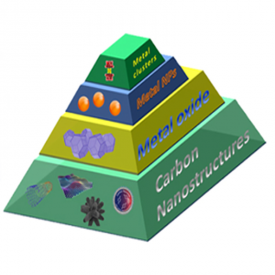The NANO-REDOX project targets the synthesis of novel electrocatalytic nano-systems with composition, dimensionality and morphology controlled at the nanoscale for catalytic sustainable energy processes including the hydrogen and hydrogen peroxide production. NANO-REDOX materials will be shaped by a modular assembly of organic-inorganic building blocks based on a precise combination of carbon nano-structures (CNS)/metal/metal oxide components with complementary properties including: molecular recognition and confinement phenomena, surface area, electron and proton transport, multi-site catalysis, stereo-electronic modulation of reactive intermediates, self-healing.
NANO-REDOX scaffolds will be based on electron-conductive carbon nanostructures (CNS), i.e. nanotubes (CNTs), nanohorns (CNHs), nanocones (CNC), carbon nanodots (CND), and exfoliated graphene (G). Surface functionalities will be implemented by CNS covalent modification and/or by combination with organic-inorganic gels, polymeric blends and ionic liquid phases (ILs). Metal-metal oxide interfaces will be shaped on CNS by tailored synthetic protocols introducing metal-oxide nano-structures and coatings (TiO2, CeO2, ZnO, WO3) together with electro-active polyoxometalate clusters (POMs) and metal nano-particles (Pd, Pt, etc.). The envisioned NANO-REDOX multi-functionality will take further advantage of the geometry, spatial organization and hierarchical order of the merged sub-components, by controlling the inter-domain connectivity, size distribution, morphology and structural anisotropy (i.e. core-shell) of the resulting nano-structures. Moreover, electroactive surfaces based on NANO-REDOX building blocks and nano-composites will be fabricated using the layer-by-layer assembly (LbL) technique and Langmuir-Blodgett (LB) film deposition that allows a valuable control over both the interfacial adhesion and the dimensional organization of the material network, spanning several orders of magnitude (from Å to cm). Fundamental electrocatalysis studies will be used to probe the NANO-REDOX systems by evaluating their electrodic response for the Oxygen/Hydrogen evolution reaction (OER/HER), the CO2 reduction reactions (CO2-RR), in terms of overpotential, faradaic current and yield, selectivity and long-term performance. Structure-reactivity relationships will build on state-of-the-art microscopy imaging and nano-tomography of the electroactive materials and surfaces.
Role of IMEM-CNR unit:
In depth characterization of the morphological, structural and chemical features of the NANOREDOX materials and electroactive interfaces by transmission electron microscopy (TEM) with analytical and tomographic capabilities. The nanostructured hybrid systems will be based on metal nanoparticles (Pd, Pt, etc) within a metal-oxide phase (TiO2, CeO2, ZnO, WO3) that envelopes CNS scaffolds, i.e. nanotubes (CNTs), nanohorns (CNHs), nanocones (CNC), carbon nanodots (CND), and exfoliated graphene (G).

NANOREDOX materials where a CNS core is enveloped by a metal oxide (magenta) phase with embedded metallic NPs (orange).
RESEARCH UNITS
- Institute of materials for electronics and magnetism (IMEM) of the National Research Council (CNR) (ITALY)
- University of Trieste (Italy)
- University of Bologna (Italy)
- University of Trieste (Italy)
- University of SALENTO (Italy)









